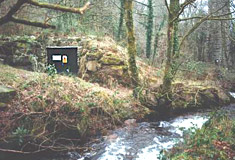Client: Western Hydro-Trelubbas
What was achieved?
a real time monitoring system to monitor Electrical production using the Hydro potential of a river and to reconcile this with revenue earned
Remote monitoring and sensing
Western Hydro Ltd. was established primarily to develop small-scale (50-1,000 kW) hydroelectric projects in the UK, while ensuring minimal impact is placed on the environment. With facilities in Devon and Cornwall, Western Hydro has concentrated its efforts in the Southwest.
Hydro-electric powerhouse buried to reduce visual impact and noise.
One of those facilities is the Trelubbas hydroelectric scheme situated on the River Cober between Coverack Bridges and Lowertown, the gateway to the Lizard Peninsular.
The power plant, although fully automated and able to govern itself, is monitored and capable of being controlled using the netrixTM remote monitoring system.
The netrixTM system has been installed and configured to provide remote monitoring of the plant’s kilowatt output and water level. It also enables control of how much water goes into the turbine. Using a web browser the plant engineer can access the site at anytime and view, in real-time, the plant’s performance.
netrixTM system configured to show power trends over a 28-day period
Alarms are configured to send alerts directly to the engineer’s mobile phone, using SMS text messaging, if there is a deviance in the process such as reverse power. On receiving the alarm the engineer is able to log on via a web browser wherever he happens to be, to determine what the problem is and whether it is necessary for him to go to the site. As well as real time monitoring, the system also provides data logging and trend analysis.
The power from the plant is transformed to 11 kV, introduced to the local grid lines in the area and purchased daily by South West Electricity Board (SWEB). The amount of electricity put on to the grid is monitored by SWEB using the Board’s own private monitoring system and Western Hydro is paid accordingly.
netrixTM system configured to show power trends over a 24-hour period
Since using netrixTM the founders of Western Hydro, Dr John Collier and Jason Goodden, have been able to independently measure and monitor output.
“SWEB already had a monitoring system which enabled them to measure the amount of electricity we put on to the grid and pay us accordingly,” explains Goodden. “But for obvious security reasons we weren’t able to access their system. It was therefore necessary for us to have our own monitoring system”.
“Furthermore the system enables us to be much more proactive rather than reactive,” continues Goodden. “Not only can we access the scheme as often as we need to, viewing the site in real-time, but we have also programmed alarms to be sent via SMS text messaging.
netrixTM system dashboard configured to show power output reading
“If we do receive an alarm I’m able to log on to the system and assess whether or not it is necessary for the site manager to visit the site. I am also able to adjust site controls online. This facility brings huge savings in both time and money. With this system we are always in control.”
Goodden believes that the system has even greater potential. “From what I have witnessed since the system has been fully operational I find it hard to believe that netrixTM has any real limitations even for other larger, more complex plant.”





